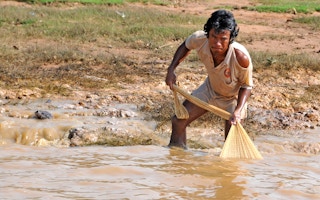Phally Chhiv placed a pot of simmering soup filled with fish and greens on a wooden platform outside her one-room home in northwestern Cambodia - using nutrient-packed minnows that experts hope can help to end global hunger.
Three children watched their grandmother prepare their lunch with tiny fish from a backyard pond - one of thousands of families across Asia and Africa being given fish by experts as part of a new project aiming to reduce malnutrition and poverty.
“It will help my grandchildren,” Phally Chhiv, 53, dressed in paisley and jungle print blouse with khaki slacks, told the Thomson Reuters Foundation in Ou Kralanh, a village about an hour’s drive from Cambodia’s Angkor Wat temple complexes.
“They won’t get diseases so often.”
The NutriFish1000 campaign, launched on Wednesday, aims to improve family nutrition in the first 1,000 days of life by getting pregnant women and children to eat small fish - dubbed “nutrient bombs” - grown in ponds and rice paddies.
Global hunger has been on the rise for three years, according to the United Nations (UN), which says that one in nine people worldwide do not have enough to eat, and 151 million children under five are stunted by malnutrition.
While almost all rural families in Cambodia eat fish from flooded rice fields during the wet season, stocks have been hit by overfishing and malnutrition remains high because of poverty, disease and a tradition of not feeding fish to young children.
“
We’re now translating that into something that is accessible for the poorest of the poor, especially women and children in rural settings, … to produce these fish in a safe, available, accessible and affordable manner.
Pawan Patil, economist, World Bank
With financing from the World Bank and the UN, NutriFish1000 projects have been rolled out in six countries, including India and Bangladesh, with plans to expand to Ivory Coast, Malawi and Ghana next year.
NutriFish1000 experts have identified 33 species of locally available small fish, up to 10 cm (4 inches) long, that they intend to promote in countries with high malnutrition rates, said Pawan Patil, a World Bank economist.
“In developed countries, there’s already the knowledge that eating certain kinds of fish is good,” he said.
“We’re now translating that into something that is accessible for the poorest of the poor, especially women and children in rural settings, … to produce these fish in a safe, available, accessible and affordable manner.”
Healthy
Cambodians receive 75 per cent of their animal protein from fish, according to the UN’s Food and Agriculture Organization.
However, they tend to eat larger varieties - which are under threat from overfishing and environmental degradation - and ignore small fish, said Bun Chantrea, a project coordinator with Malaysia-based WorldFish, part of the NutriFish1000 initiative.
“About seven years ago, fish in the stream in my village started decreasing,” he said. “Many fishers stopped fishing.”
WorldFish has provided 180 families in Cambodia with tiny fish to breed in ponds on their properties, as well as stocking community ponds, which often overflow into rice paddies in the rainy season, allowing fish to breed there too.
Villagers lay nets in the rice paddies, using tall poles to push canoes through a sea of vivid green rice stalks to harvest their catch.
By eating tiny fish, packed with fats, vitamins and minerals like iron, calcium and zinc, pregnant women and children can get the nutrients they need to be healthy.
”(With) small fish, you can even eat the bones, which have lots of micronutrients,” said Shenggen Fan, head of the Washington-based International Food Policy Research Institute. “It’s a perception thing. Somehow we think small fish is waste.”
If the trend of breeding small fish for food catches on, minnows could help reduce malnutrition in Cambodia, where one in four children under five are underweight and one in three are stunted, according to government data.
“These small fish are like nutrient bombs,” said Arun Padiyar, a project manager for WorldFish in India’s eastern Odisha state, where 500 households are using fish farms.
WorldFish has entered into a five-year partnership with the government of Odisha with the aim of growing its fisheries sector and attracting private sector investment.
“The catch we get now is much bigger. It has helped me support my four children,” said Parboti Sri, a 45-year-old widow who fishes at a community pond in the village of Tolakchuin.
“There is also more to eat, which is always good,” said Sri, whose earnings have risen by a quarter to about 4,000 Indian rupees ($54) a month since WorldFish stocked a pond earlier this year.
This story was published with permission from Thomson Reuters Foundation, the charitable arm of Thomson Reuters, that covers humanitarian news, women’s rights, trafficking, property rights, climate change and resilience. Visit http://news.trust.org)








